
Leader House is a Georgian townhouse located on Surrey Street in the city centre of Sheffield, England. It overlooks Arundel Gate and is a Grade II listed building.

Leader House is a Georgian townhouse located on Surrey Street in the city centre of Sheffield, England. It overlooks Arundel Gate and is a Grade II listed building.
The house was built in 1770 by the Duke of Norfolk for his agent Vincent Eyre, however there is no evidence that Mr. Eyre actually lived in the house. In 1777 Thomas Leader leased the house, Leader was a silversmith, originally from Broxted in Essex who came to Sheffield to set up the firm of Tudor, Leader & Co. in 1762 with Henry Tudor. The firm's speciality was high quality snuff boxes. The house became known as Leader House at this time and has continued to be called so up to the present day with the Leaders emerging as one of the eminent families of Sheffield, becoming newspaper publishers and historians. [1] [2]
In 1780 there was a reorganisation of the street plan around the house which resulted in the garden on the west side being spoilt, to compensate for this, the Leaders leased a garden plot on the opposite side of the house. In the late 1780s the house was enlarged at the rear and a bay window was added on the north side. Thomas Leader retired in 1797 but his family continued to reside there until 1817 with one of his sons Daniel living in the house for a time. In 1817 Leader House was sold to the Pearson family and between 1853 and 1873 Mr Pearson’s daughter lived there with her husband, the surgeon H. Brown Fisher. Charles Wardlow, owner of Wardlows Steel Company on Carlisle Street in Sheffield bought the house in 1872 and later his son Marmaduke lived there, spending large amounts of money to renovate and improve the building. [3]
The house was sold by the Wardlows in 1920 and had several occupants in the following years including the silversmith company Thomas Bradbury & Son whose workshops were in nearby Arundel Street, and the accountants Joshua Worley & Sons who later moved to Paradise Square. The house was purchased by Sheffield Corporation in May 1938 and was designated as a listed building in May 1952. On 20 March 1970 Sheffield Corporation applied to the Minister of Housing for Listed Building Consent to demolish Leader House so a modern circular register office could be built on the site.

The project was strongly opposed by the Hallamshire Historical Building Society which resulted in a public enquiry being held in September 1970. On 27 November 1970 the Minister gave the decision that Leader House should not be demolished. The circular register office known locally as the “Wedding Cake” was eventually constructed on a site 100 metres to the SW and was demolished in 2004. [4]
From 1970 Leader House was leased out by the Council and became part of the Sheffield Polytechnic which later became Sheffield Hallam University. In recent years the building has reverted to use by Sheffield City Council and is now the administration offices of Museums Sheffield. The late 1880s extension to the rear of Leader House is classed as a separate building with the address 2 Surrey Place, for many years it housed the Central Deaf Club, it is now used by The Source Skills Academy, a training and development organisation.
Leader House is brick built with a slate roof with one brick and two rendered gable stacks. On the north side is the main pedimented door with Doric columns and a large canted bay window. The house is three storied with a three window range at the front, these being twelve pane sashes on the first two floors and six pain sashes on the top storey. [5] [6]
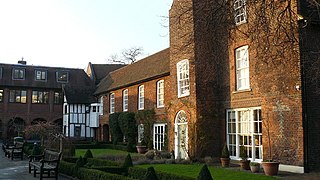
Croydon Palace, in Croydon, now part of south London, was the summer residence of the Archbishop of Canterbury for over 500 years. Regular visitors included Henry III and Queen Elizabeth I. Now known as Old Palace, the buildings are still in use as the Old Palace School, an independent girls' school of the Whitgift Foundation. It has been a grade I listed building since 1951.
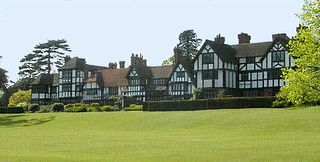
Tudor Revival architecture, also known as mock Tudor in the UK, first manifested in domestic architecture in the United Kingdom in the latter half of the 19th century. Based on revival of aspects that were perceived as Tudor architecture, in reality it usually took the style of English vernacular architecture of the Middle Ages that had survived into the Tudor period. The style later became an influence elsewhere, especially the British colonies. For example, in New Zealand, the architect Francis Petre adapted the style for the local climate. In Singapore, then a British colony, architects such as Regent Alfred John Bidwell pioneered what became known as the Black and White House. The earliest examples of the style originate with the works of such eminent architects as Norman Shaw and George Devey, in what at the time was considered Neo-Tudor design.

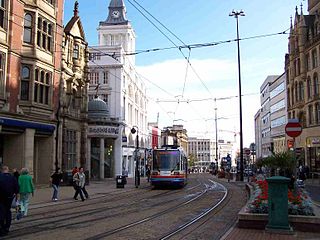
High Street is one of the main thoroughfares and shopping areas in the city centre of Sheffield in South Yorkshire, England, located at the approximate grid reference of SK356874. High Street starts at the Commercial Street, Fitzalan Square and Haymarket junction and runs for approximately 400 metres west to conclude near the Sheffield Cathedral where it forms a Y-junction with Fargate and Church Street. High Street has the traditional wide variety of shops, financial institutions and eating places which are associated with any British town centre.

Sutton Place, 3 miles (4.8 km) north-east of Guildford in Surrey, is a Grade I listed Tudor manor house built c. 1525 by Sir Richard Weston, courtier of Henry VIII. It is of great importance to art history in showing some of the earliest traces of Italianate renaissance design elements in English architecture. In modern times, the estate has had a series of wealthy owners, initially J. Paul Getty, then the world's richest private citizen, who spent the last 17 years of his life there. Its current owner is Russian billionaire Alisher Usmanov. A definitive history of the house and manor, first published in 1893, was written by Frederic Harrison, jurist and historian, whose father had acquired the lease in 1874.

Church Street is situated in the centre of Sheffield, South Yorkshire, England, at the grid reference of SK353874. It runs for approximately 490 yards (450 m) in a westerly direction from its junction with Fargate and High Street to its termination at the crossroads formed by the junction with West Street, Leopold Street and Townhead Street. Church Street has its own Sheffield Supertram stop directly in front of the Sheffield Cathedral and it carries that name.
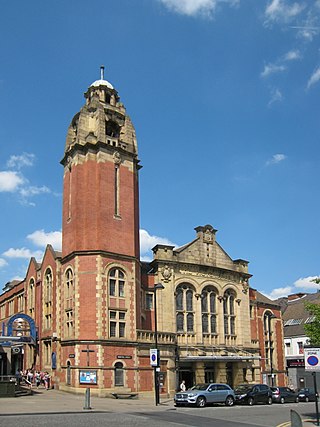
Victoria Hall is a Methodist place of worship situated on Norfolk Street in Sheffield city centre. It is the most important Methodist building in Sheffield and it is a Grade II listed building. It is a large many roomed building which stands between the side streets of Chapel Walk and George Street. Although the main entrance to the church is on Norfolk Street, there is a separate administration entrance on Chapel Walk.

Endcliffe Hall is a 19th-century, 36-room mansion situated on Endcliffe Vale Road in the City of Sheffield in the suburb of Endcliffe. The hall is situated just over 2 miles (3.2 km) west of the city centre and is a Grade II* Listed building.

Cornish Place is a listed building situated in the Neepsend area of the City of Sheffield. The building was formerly the factory of James Dixon & Sons, a Britannia metal, Sheffield plate and Cutlery manufacturer. In the late 1990s the disused building was cleaned and converted into apartments, it is regarded as the most impressive cutlery works that still stands in Sheffield and rivals the cotton mills of Lancashire and the West Riding in terms of architectural quality and heritage. The east and west ranges of the structure are the most spectacular, with Grade II* listed classification, while the rest of the works receive the lower Grade II category. The "Cornish" in the buildings name is thought to derive from the manufacture of Britannia metal which is made up of 93% tin which came from Cornwall.

Tapton Hall is a Grade II listed building situated on Shore Lane in the Crosspool area of Sheffield, England.

Mount Pleasant is an 18th-century mansion situated on Sharrow Lane in the Highfield area of the City of Sheffield in South Yorkshire, England. The house stands just under two km south of the city centre and is a grade II* listed building, it has been described as "one of the best 18th century houses in Sheffield". The adjacent former stables and coach house are also Grade II* listed.

The Beehive Works are a purpose-built cutlery works located on Milton Street in the Devonshire Quarter area of Sheffield city centre. The works were built in stages in the second half of the 19th century and are designated as a Grade II* listed building with English Heritage stating that they are of special architectural and historic interest as an examples of buildings associated with Sheffield's metal manufacturing and metal working trades. The works stand adjacent to the Taylor's Eye Witness Works and together they make Milton Street one of the best places to gain an impression of Sheffield’s former cutlery industry.

Oakes Park is a privately owned, historic park land in the green-belt area of south Sheffield. It contains 15 private homes as well as a 17th-century English country house which now operates as The Oakes Holiday Centre, a Christian, residential activity centre for young people between the ages of 8 and 18. It is set in extensive grounds which make it very difficult to be seen by the general public. It is situated on Norton Lane in the suburb of Norton within the City of Sheffield in England. The house is a Grade II* listed building, as are several other buildings and features.
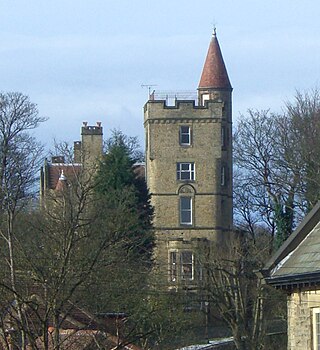
The Towers is a small English country house situated in Sheffield, England. The house stands on Sandygate Road close to the junction with Coldwell Lane in the suburb of Crosspool. It is a Grade II listed building as is the lodge and attached gateway and the concave garden wall. It has been described as “an extraordinary Scottish baronial fantasy”.

Stumperlowe Hall is a small English country house situated in the City of Sheffield, England. It is located on Stumperlowe Hall Road at its junction with Slayleigh Lane in the suburb of Fulwood. The hall is a Grade II listed building.

Fulwood Hall, is an English country house situated on Harrison Lane in the suburb of Fulwood in Sheffield, England. It is a Grade II listed building. The hall stands in a lofty position on the north side of the Mayfield Valley at a height of 270 metres. The hall is referred to as Fullwood Hall on old maps and the gate to the hall uses this spelling with two Ls.
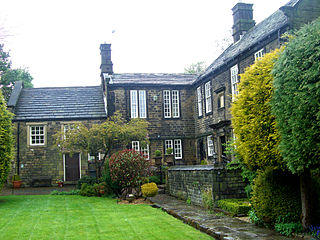
Birley Old Hall is a small English country house situated in the Birley Edge area of the City of Sheffield, England. The hall stands in an exposed situation at almost 200 metres above sea level on Edge Lane, some six km NW of the city centre and has been designated a Grade II listed building by English Heritage as has the Falconry which stands in the garden.

Riverdale House is a Victorian mansion located at 89 Graham Road in the Ranmoor area of Sheffield, England. Formerly a private residence, the building, which is Grade II Listed has now been adopted for commercial use and accommodates several small businesses.

John Dodsley Webster FRIBA (1840–1913) was an English architect who designed more than 15 churches in Sheffield in various Gothic styles, usually working to a tight budget. His work also included hospitals and commercial buildings, small country houses and private houses. All his known work was carried out in the South Yorkshire and North Derbyshire area except for a chapel and school built in Coventry.
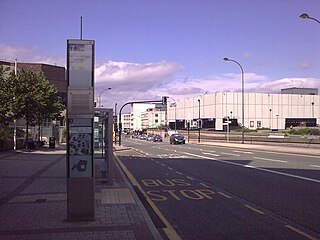
Arundel Gate is one of the main thoroughfares in Sheffield, England. It is located in the Heart of the City area of Sheffield City Centre. Arundel Gate also features a fifteen-stand bus station, including a ticket office building, completed in 2005.